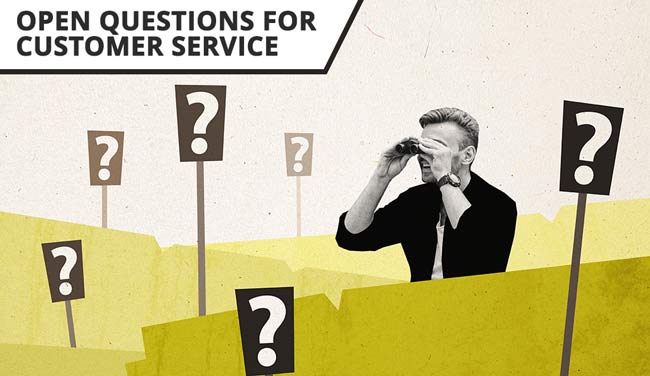18th September 2024

Do you know the difference between open and closed questions in customer service?
If you’re not sure, see what Jacqui Turner of Turner Corner Learning Solutions has to say, as she explains what really defines an open question and shares plenty of examples for your team to use – from open questions to use at the start of a call to open questions to use when responding to a complaint.

Open questions are those that encourage detailed, expansive responses from the customer. They typically begin with words like “What”, “How”, “Why”, or “Describe”, and cannot be answered with a simple “yes” or “no”.
The benefit of using open questions during calls, particularly early on in the conversation, is that they can prompt the customer to provide more information, explain their thoughts in more depth, or elaborate on a topic.
In contrast, closed questions are designed to elicit specific, often brief, responses from customers. They can usually be answered with a simple “yes” or “no”, or with a specific piece of information. Closed questions often begin with words like “Do”, “Is”, “Are”, or “Have”.
The key difference between open and closed questions lies in the depth and breadth of the information they generate.
Open questions allow for a wide range of responses and can reveal unexpected insights, while closed questions are more focused and limit the scope of possible answers.
Here are several examples of open questions your team can use in common contact centre scenarios:
“What can I help you with today?” or “How may I assist you with your account?” are useful open questions to introduce at the start of a call, as they encourage the customer to provide detailed information to help you understand their query.
The TED technique is also great for framing open questions to encourage more information, particularly when the customer hasn’t provided enough detail and you want to avoid making assumptions.
For example:
Want to refresh your call centre opening spiel? Read our article: 10 Catchy Greeting Examples for Customer Service
When responding to a complaint, there may be a need to understand the issue in more detail and particularly how this has affected the customer. Understanding the impact enables the advisor to empathize.
For example:
It’s also important to avoid making assumptions by establishing what the customer may already know or not know, or what action they’ve already taken or not taken.
For example:
It can also be beneficial to gauge the customer’s expectations by asking questions such as:
This enables the agent to provide a very early positive response, if this request can be met, or even exceeded.
If not, the agent should then focus on an alternative solution they can offer and ensure they lead with this when they respond to the customer, thus avoiding “Unfortunately…”.
If you are looking for advice on how to improve the complaints process in your contact centre, read our article: Customer Complaints? Try This 10-Point Plan
When closing calls, it’s important to ensure the customer understands what has been agreed and is happy with the outcome.
“What else can I help you with today?” or “What questions do you still have about what we’ve covered?” can both help avoid unwanted repeat contacts.
The customer may have been so engrossed in the conversation about their main point, they may need a little reminder of any other questions they wanted to ask.
You don’t want the customer hanging up and then ringing back a few minutes later when they remember they had another question!
If you work in sales, additional open questions might also include:
Finally, “How do you feel about the solution we’ve discussed?” is a question that helps to measure the customer’s satisfaction and may lead to a further discussion if the customer isn’t fully satisfied.
Looking for some great closing spiel and advice? Read our article: The Top 10 Call-Closing Statement Examples
Open questions are particularly important when you’re trying to understand how your customers perceive your service in order to retain them.
These questions could include:
When asking these types of questions, it’s important to actively listen, avoid interrupting or being defensive.
These questions help in understanding the customer’s perspective, identifying areas for improvement, and demonstrating a commitment to the customer’s long-term satisfaction.
If you show empathy and a willingness to take on board feedback as well as share how you will use their feedback, your customer is more likely to feel you truly value their thoughts.
Do you want to download this to share with your team?
Get your free download of 20 Open Questions for Customer Service now:
Open questions are a powerful tool for any customer service professional, particularly in call centres.
Their strategic use can transform interactions, elevating them from mere transactional conversations to meaningful discussions that build customer relationships and drive business success.
By introducing open questions throughout the customer journey – from initial contact to complaint resolution and retention efforts – customer service advisors can:
Open questions empower customers to take an active role in problem-solving, leading to more satisfying resolutions and a greater sense of partnership with your company.
By training advisors to use these questions skilfully, organizations can enhance their service quality, improve customer satisfaction, and ultimately drive business growth.
Written by: Jacqui Turner of Turner Corner Learning Solutions
If you want to learn more about customer service questioning techniques, read these articles next:
Reviewed by: Megan Jones